Ongoing work at Wrest Park
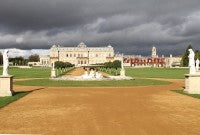 Wrest Park is the latest addition to the portfolio of English Heritage gardens. Situated near the village of Silsoe in Bedfordshire, it was acquired in 2006 and relaunched to the public in August 2011.
Wrest Park is the latest addition to the portfolio of English Heritage gardens. Situated near the village of Silsoe in Bedfordshire, it was acquired in 2006 and relaunched to the public in August 2011.
Work is still ongoing to return the extensive estate to its former glory but, as our editor discovered, there is still much to admire about one of the great 'hidden' treasures of England
Wrest Park was home to the de Grey family for over six hundred years. The present house, built in the 1830s and designed by Thomas 2nd Earl de Grey, is in the 18th Century French style. It stands in magnificent gardens, originally laid out by Henry Duke of Kent, that form one of the most complete remaining 18th century formal landscapes in the country, with additions that mark every major development in English garden design until the mid 19th century.
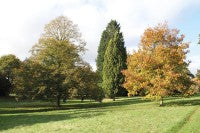 Wrest Park also has a number of important 18th and 19th century garden buildings, including Thomas Archer's magnificent baroque pavilion and an interesting collection of garden statuary.
Wrest Park also has a number of important 18th and 19th century garden buildings, including Thomas Archer's magnificent baroque pavilion and an interesting collection of garden statuary.
Many famous landscape designers were employed by different members of the de Grey family over the years. These included Thomas Ackres, Batty Langley, Thomas Archer, Thomas Wright, William Kent and Lancelot 'Capability' Brown, and most examples of their work can still be seen today.
In 1658, formal gardens at Wrest Park were noted as the work of Amabel second wife of Henry 10th Earl of Kent. Amabel, together with her son, expanded the gardens during the 1670s and, in 1680, dug out the long water which formed the basis of the garden design.
However, it was the work carried out during the 18th century, with the creation of the woodland garden, that set the presiding influence over all later developments.
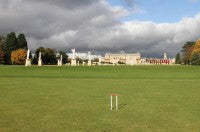 Capability Brown was brought in by Jemima Marchioness Grey to soften the edges of the garden and remodel the park in 1758. His influence can be seen in the serpentine canals that form an artificial river around the great garden.
Capability Brown was brought in by Jemima Marchioness Grey to soften the edges of the garden and remodel the park in 1758. His influence can be seen in the serpentine canals that form an artificial river around the great garden.
Thomas Earl de Grey inherited the estate in 1833 and quickly realised his plans, building a new house 200 yards down the drive, knocking down the old house, that he thought cold and damp, and adding large formal gardens and walled kitchen gardens in the space between the new house and old gardens.
Wrest Park remained in the hands of the family until 1917 when the last line of the family, Aubron Thomas Herbert 9th Baron Lucas, was killed in the First World War. The estate was sold off to John George Murray, a brewing and mining magnate, who himself had to sell off Wrest Park. It was placed on the market in 1934, but a buyer was not found until 1939 when the Sun Insurance Company made it their headquarters.
After the Second World War, the insurance company sold off the estate to the Ministry of Works, who leased it to the National Institute of Agricultural Engineering, later called the Silsoe Research Institute. For over eighty years, the Institute was the main centre of agricultural engineering research, building up  an international reputation. In 2006, the Institute closed, affording English Heritage the opportunity to reopen the gardens to the public following major refurbishment.
an international reputation. In 2006, the Institute closed, affording English Heritage the opportunity to reopen the gardens to the public following major refurbishment.
John Watkins is Head of Gardens & Landscapes for English Heritage; he oversees the gardens and landscapes that can be found amongst over four hundred of the Governmental body's sites.
John took up the position in 1999, providing policy advice and technical guidance on the maintenance and management of designed landscapes and historic parks and gardens. Formerly Senior Lecturer at Hadlow College in Kent, he has worked at the Royal Botanic Gardens at Edinburgh and Kew, the National Trust for Scotland and the RHS at Wisley and Hyde Hall. He has been on the management board of Plant Network and was Chair of Trustee of the Great Dixter Charitable Trust, which look after the nationally important planting at the East Sussex estate. He has served as an examiner for the RHS, and judges at RHS shows.
John heads up a number of colleagues who bring various skills to the table in terms of managing and conserving historic gardens and designed landscapes.
I, myself, have fond memories of Wrest Park as, during my time studying for a Masters Degree at the then Silsoe Campus (Cranfield University), back in 2002, I stayed at the campus for a year and regularly exercised around the gardens with my fellow students. I even gave them plant identity lessons whilst running. Even then it was an awe inspiring place, the ambience and scale of the gardens were immense. I also remember seeing the large croquet lawns, and imagined how fine they must have looked in their heyday.
(Cranfield University), back in 2002, I stayed at the campus for a year and regularly exercised around the gardens with my fellow students. I even gave them plant identity lessons whilst running. Even then it was an awe inspiring place, the ambience and scale of the gardens were immense. I also remember seeing the large croquet lawns, and imagined how fine they must have looked in their heyday.
For me, having another chance to walk around the gardens with John was rather special. Our first point of call was to meet up with the gardening team. Corrine Price is the Upper Gardener and Apprentice Manager, who works under the Head Gardener, Chris Slatcher who, regrettably, on the day of my visit, was away on leave.
Corrine is responsible for planning and managing all the upper gardens, e.g. those around the house, visitor centre and walled gardens. She, along with Chris, manages six apprentices and three full time gardeners. Any additional labour is sourced from a one hundred strong local volunteering force. These volunteers help at different times of the week to suit the needs of the park.
During the summer months, the main lawns, all the hedges and any pesticide spraying is put out to a local contractor who also cuts the large lawn areas on a weekly basis. However, Corinne and her team maintain the lawns around the house.
 John was keen to explain that the first job English Heritage had to do when they took over Wrest Park was to draw up a twenty year management plan, spending many months researching old records, plans and pictures of the park to obtain enough information to understand the garden and its many layers, and then produce a schedule of work to restore them to their former glory.
John was keen to explain that the first job English Heritage had to do when they took over Wrest Park was to draw up a twenty year management plan, spending many months researching old records, plans and pictures of the park to obtain enough information to understand the garden and its many layers, and then produce a schedule of work to restore them to their former glory.
Once the information was collated, it was a case of prioritising and costing the work required and then applying to the Heritage Lottery Fund for their support. To ensure the gardens would be a success, it was important to firstly build and develop a visitor centre to include a cafe, shop and car parking. This was done in conjunction with refurbishing a number of the walled gardens to form the entrance and welcome area, which also included a large children's play area.
Other work centred on rebuilding and refurbishing a series of paths to restore the historic setting and improve public access around the gardens. These were all relaid or resurfaced using a Coxwell self-binding gravel from Grundon Sand and Gravel. A new lawned access pathway for 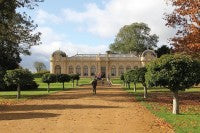 wheelchair access was constructed using reinforced Netlon fibres in the rootzone to help stabilise the turf and reduce wear. A major dredging of one of the canals also took place, along with repairs to the sluice that controls the water flow through the network of canals.
wheelchair access was constructed using reinforced Netlon fibres in the rootzone to help stabilise the turf and reduce wear. A major dredging of one of the canals also took place, along with repairs to the sluice that controls the water flow through the network of canals.
The sheer size and scale of the gardens is very impressive, as is the Orangery. This delightful building is regularly used for weddings and educational purposes. The park is busy throughout the year with corporate and private functions, evidence of which was the dismantling of the marquees, during my visit, from the last wedding event of the year.
John was keen to show me the canals and large waterways that run around the perimeter of the site, along with the avenue walkways leading to the many hundreds of statues on display around the park.
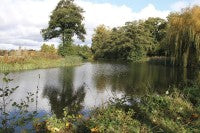 The combination of wet and mild weather has seen an increase in chafer grub activity and, unfortunately, large tracts of grass either side of the main central waterway have been damaged by badgers searching for the grubs. John explained that, once they have stopped feeding, it will be case of relevelling and reseeding ready for next spring's onrush of visitors.
The combination of wet and mild weather has seen an increase in chafer grub activity and, unfortunately, large tracts of grass either side of the main central waterway have been damaged by badgers searching for the grubs. John explained that, once they have stopped feeding, it will be case of relevelling and reseeding ready for next spring's onrush of visitors.
I was also able to see some of the key landscape changes that previous family members had made to leave their mark on Wrest Park, including tree planting schemes, particularly by Capability Brown, who planted extensively. However, many of the trees were felled in the years running up to the Second World War and also as a result of Dutch Elm Disease in the 1970s.
 However, those that remain offer a glimpse into a spectacular past, and it is still possible to see the fruits of Capability Brown's labours with many large, mature trees surviving. These include larch, elm, suckers and oak, plus one very large and majestic tulip tree, thought to be amongst the biggest in the country. At the time of my visit, in late October, its leaves were turning into the most stunning bright yellow.
However, those that remain offer a glimpse into a spectacular past, and it is still possible to see the fruits of Capability Brown's labours with many large, mature trees surviving. These include larch, elm, suckers and oak, plus one very large and majestic tulip tree, thought to be amongst the biggest in the country. At the time of my visit, in late October, its leaves were turning into the most stunning bright yellow.
A monument was erected on site that officially thanked Lancelot Brown for his professional assistance in the years 1758, 1759 and 1760.
There is also a Giant Sequoia that was once regularly used in the old house as a Christmas tree, until it got too big and was planted out in the garden!
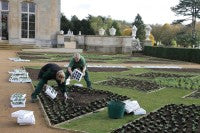 As John and I made our way back to the main house, we were able to see one of the latest projects in progress - the American Garden. Here, the team are recreating one of the original designs, a formal yew, laurel and rhododendron plantation that was originally laid out in 1857. Closer to the house, I was able to see the ongoing work on the French and Italian parterre gardens where they are trying to establish new box hedging. Also on show was the new rose garden, hosting a new collection of roses donated by Austin Roses.
As John and I made our way back to the main house, we were able to see one of the latest projects in progress - the American Garden. Here, the team are recreating one of the original designs, a formal yew, laurel and rhododendron plantation that was originally laid out in 1857. Closer to the house, I was able to see the ongoing work on the French and Italian parterre gardens where they are trying to establish new box hedging. Also on show was the new rose garden, hosting a new collection of roses donated by Austin Roses.
As for the formal lawns and two large croquet lawns, these only get cut on a weekly basis, and not much else is done to them! This was evident in the fact that the croquet lawns, which are actually managed by the croquet club, were covered in moss, wormcasts and looked a sickly yellow colour. However, although the local club still enjoy playing their matches on them in the summer months, English Heritage are in the process of looking to provide them with new lawns that will be situated away from the house and closer to Silsoe village, making it more convenient for both parties.
In this article, I have only scratched the surface of the work being undertaken at Wrest Park. There is still plenty to do, with the lawns in particular needing some intensive remedial work. However, under the very capable management of English Heritage, it will continue to develop into a top attraction and become one of the jewels in their ever growing portfolio.
Wrest Park is certainly worth a visit.
